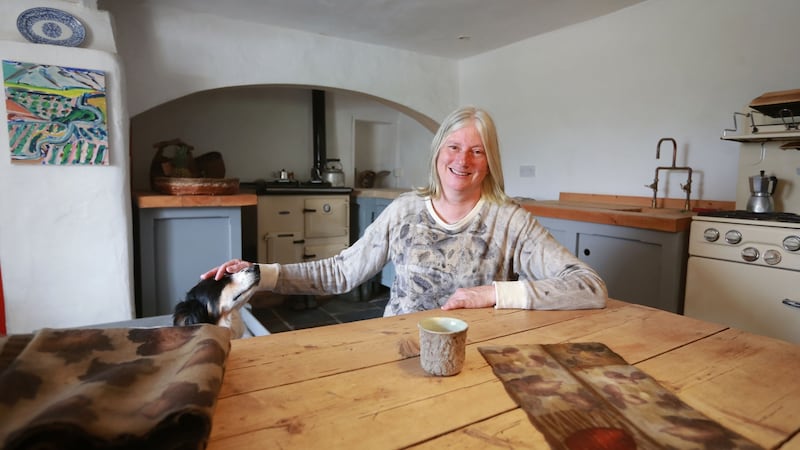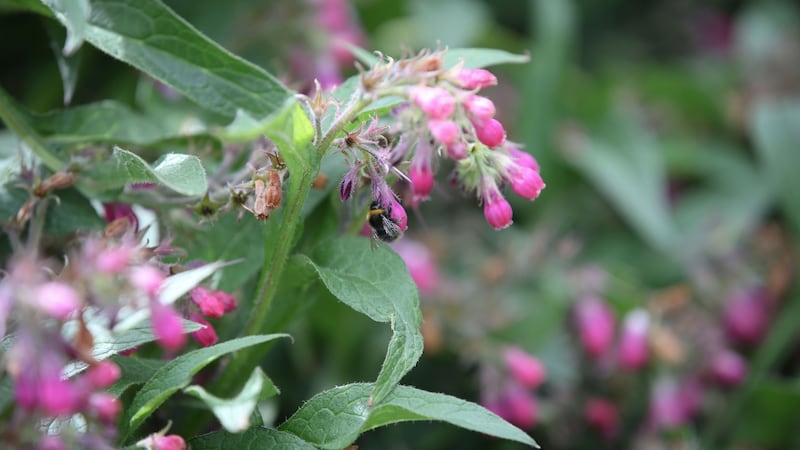On her Instagram feed, Nicola Brown describes herself as "a felter, ecoprinter, natural dyer, gardener, pocket farmer, forager, sewist, teacher & online tutor" as well as "an outdoor, tree, thrift store & recycling fanatic".
It's quite the job title but one that captures the wide scope of this textile artist's many talents and interests. Brown's home, Clasheen, a traditional two-up, two-down old farmhouse near Borris, Co Carlow surrounded by 18.5 acres of meadows, woodland and gardens, is where she works much of her special magic, using fresh plant material such as leaves, seeds, flowers and other plant parts, to create her beautifully nuanced, hand-printed textiles. When she bought it in 2004, the building had lain uninhabited for almost 80 years and was without either electricity or running water. For the same reason its vernacular architecture had remained wonderfully intact, its neat roof of Welsh slate tiles, its lime-rendered exterior and its traditional small window openings the very same as they were when its previous owners had last lived there during the early 1930s. The house's subtle and historically respectful renovation under Brown's watchful eye (she did a lot of the initial work herself) is a measure of how much her artistic sensibilities inform both her life and her work.

Brown came to the world of textile art relatively recently (2007) but so quickly and so thoroughly immersed herself in it that she was soon giving international workshops on the subject. In particular, she’s known for her masterful use of the technique known as eco-printing or botanical printing, where the shape and texture of various plant parts and the range of botanical dyes that they yield – gold, plum, pink orange, carrot red, sooty purple, shades of ochre, yellow and green – are used as natural printing “plates” that can be transferred to a range of fabrics and materials.
The sharply-toothed, oval leaves of the wild blackberry, for example, are prized by Brown for the elegantly inky silhouette that they leave behind, a sort of ghostly botanical handprint, while she loves using eucalyptus leaves for the rich, rusty-red hues they give and the distinctly lobed, serrated leaves of sycamore for their strongly architectural shape.
“I’ve always has a thing about trees, even before I became interested in natural dyes and eco-printing”, she says. “In fact one of the very first things that I did when I bought the extra land around the house [in addition to the original one-acre site, she purchased a further 17.5 acres in 2009] was to plant more than 13,000 native trees including pedunculate oak, birch, Scots pine and ash.”
In the end she was forced to fell all of her young ash trees, as one by one they became victim of the disease known as ash dieback (Chalara fraxinea). Undeterred, Brown used it as an opportunity to fill the space with hazel, alder, sycamore, spindle, Spanish chestnut, mountain ash and sessile oak, all trees whose leaves she loves to use in her textile artwork.

Last year she also started planting what she describes as her dye borders, a series of generous beds that wrap themselves around her new purpose-built studio and that she’s filled with yet more plants prized for their botanical printing properties including varieties of herbaceous peonies, tickweed, epimideum, perennial geranium, persicaria, Jacob’s ladder, campanula, artemisia, yarrow, hooker’s inula, ligularia and bee-balm. Naturally green-fingered, she shares her horticultural gene with her mother as well as with relatives on both sides of her family.
"A great-uncle on my father's side, Billy Rae, had a very well-known plant nursery in Mulhuddart that he ran with my great-aunt Gladys. As a young child, I always loved visiting them. Meanwhile my maternal grandmother also ran a busy nursery near Loughlinstown called Ellington Nurseries, so you could say that I come from a long line of gardeners."
Many of the print and dye plants growing in her garden's new borders were sourced from Clare-based Caherhurley Nursery while others are gifts from friends, gardeners and dyers, including a few that took a circuitous route to reach Clasheen. The traditional dyer's plant known as weld or dyer's rocket (Reseda luteola), for example, came from seed sourced by a friend from a botanical dyer in Norway, a particular strain prized for the especially rich yellow pigment that its roots yield. Others came from fellow Irish gardeners and plant enthusiasts including the decorative perennial known as giant herb robert (Geranium maderense). Loved by Brown for its pink flowers and handsomely dissected architectural foliage, it was a gift from the well-known garden writer Mary Davis, a longtime family friend.

Eucalyptus are a particular passion, one that she shares with the Wexford-based eucalyptus grower and breeder Brendan Doyle of D Plant Horticulture who has helped her to raise species/varieties of this genus of evergreen trees from seed.
“I grow lots of different eucalyptus for their botanical dye properties; Eucalyptus cordata, Eucalyptus parvifolia, Eucalyptus nicholii, Eucalyptus gunni ‘Azura’, and a lovely new compact variety called Eucalyptus ‘Moon Lagoon’.” Well-known ornamental garden shrubs and trees that also grow in the dye gardens of Clasheen include the smokebush (Cotinus coggygria), the katsura (Cercidiphyllum japonica), redbud (Cercis canadensis ‘Rising Sun’), stag’s horn sumach (Rhus typhina), tree of heaven (Ailanthus ailtissima) and Korean oak (Quercus dentata ‘Carl Ferris Miller’).
Other plants have arrived uninvited but are still heartily welcomed. So while many might shudder at the thought of letting the invasive wildflower rosebay willowherb (Epilobium angustifolium ) weave its merry way through a border, Brown takes a more laissez-faire approach, her artist’s eye instead seeing it as a creative opportunity. “It has the most beautiful seed pods that are fantastic for ecoprinting. I love using them.”
Before the pandemic struck, Brown regularly travelled the world giving her textile workshops. While lockdown has put paid to these for the moment, it’s also afforded her the precious opportunity to connect with the garden, meadows and woodlands of Clasheen in a way that she’s found deeply enriching.
“It’s been amazing. I’m so grateful to be surrounded by so much natural beauty and so glad that I finally got going on creating the new dye beds last year. I’m really getting to enjoy the fruits of all that hard work and to appreciate the subtle, day-to-day differences as plants slowly fill out and flower, while I’m also discovering so much about the garden wildlife that I share the land with.”
The recent discovery that a badger had set up home at Clasheen thrills her, even if it has also meant the sudden appearance of carefully excavated holes in the ground next to prized plants. On a professional level, lockdown has also given her the opportunity to expand her range of online textile art workshops, which have proved hugely popular.
“Introducing others to the world of ecoprinting has always been a joy but my online workshops allow me to connect with people from all over the world without even taking a step outside the garden gates. That’s pretty amazing.”












